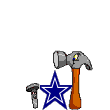McKDaddy
Well-Known Member
- Messages
- 10,538
- Reaction score
- 11,385
I'm actually ok with both calls tonight as catches (they meet my definition of what a catch should be). However, it is complete BS when comparing them to calls we see every week where they claim player didn't meet some standard of the catch rule yet they are essentially the exact same scenario we saw tonight or the ruling runs afoul of the actual language of the rule.
"maintains control of the ball after (a) and (b) have been fulfilled, until he has the ball long enough to clearly become a runner. A player has the ball long enough to become a runner when, after his second foot is on the ground, he is capable of avoiding or warding off impending contact of an opponent, tucking the ball away, turning up field, or taking additional steps"
How was Jessie James (Pittsburgh game) not in control of the ball & making a football move to extend the ball to the goal line?
How did Dez not tuck the ball & turn up field (which would meet two of the 4 stated criteria)? Is lunging not the equivalent of taking additional steps? If so, why wouldn't it be? It is part of an athletic act common to the game.
If a guy on his knees catches the ball at the one & falls to the goal line, is he not controlling where his body goes even though he can't take "additional steps" because he is on his knees?
The whole "going to the ground" is another major part of the problem.There is a world of difference between going to the ground voluntarily and being contacted which causes you to go to the ground. I could be OK with language that held a receiver player to a higher standard when it is voluntary (ie, NO contact by defender). But when someone is being drilled by a defender which causes them to stumble for multiple steps & go down and the ball moves upon hitting the ground, they should be deemed to have completed the catch.
Bottom line - we need a whole lot more consistency in how rules are written & how they are enforced and we need to change the rules to the simplest possible interpretation of what is a catch.
"maintains control of the ball after (a) and (b) have been fulfilled, until he has the ball long enough to clearly become a runner. A player has the ball long enough to become a runner when, after his second foot is on the ground, he is capable of avoiding or warding off impending contact of an opponent, tucking the ball away, turning up field, or taking additional steps"
How was Jessie James (Pittsburgh game) not in control of the ball & making a football move to extend the ball to the goal line?
How did Dez not tuck the ball & turn up field (which would meet two of the 4 stated criteria)? Is lunging not the equivalent of taking additional steps? If so, why wouldn't it be? It is part of an athletic act common to the game.
If a guy on his knees catches the ball at the one & falls to the goal line, is he not controlling where his body goes even though he can't take "additional steps" because he is on his knees?
The whole "going to the ground" is another major part of the problem.There is a world of difference between going to the ground voluntarily and being contacted which causes you to go to the ground. I could be OK with language that held a receiver player to a higher standard when it is voluntary (ie, NO contact by defender). But when someone is being drilled by a defender which causes them to stumble for multiple steps & go down and the ball moves upon hitting the ground, they should be deemed to have completed the catch.
Bottom line - we need a whole lot more consistency in how rules are written & how they are enforced and we need to change the rules to the simplest possible interpretation of what is a catch.





